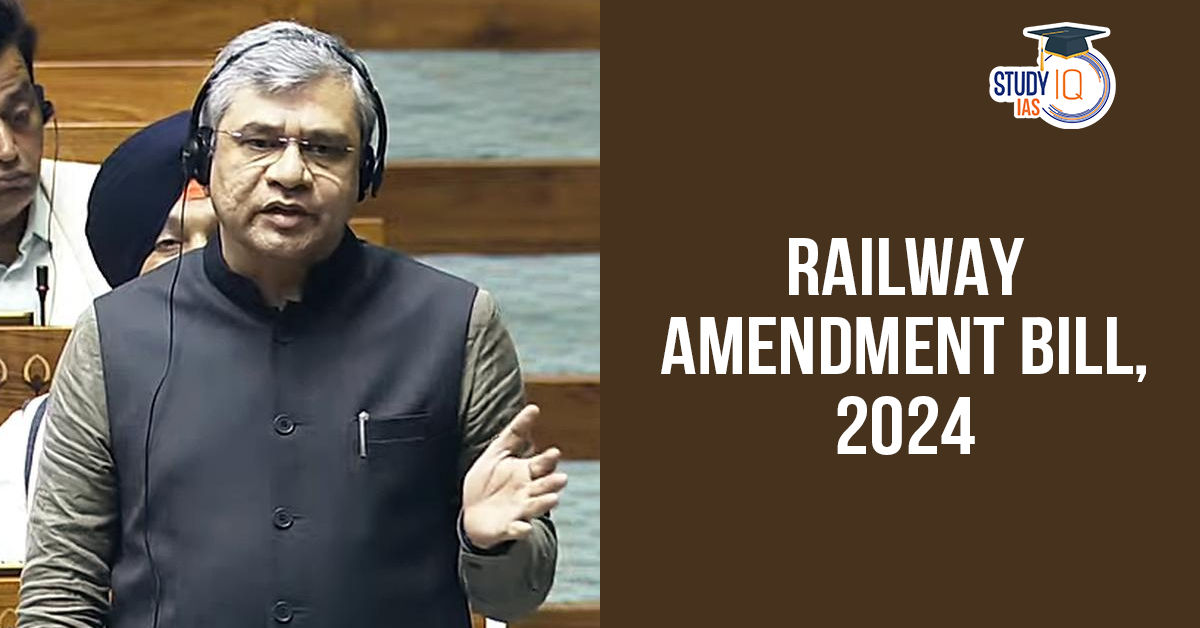Table of Contents
The government introduced the bill to repeal the Indian Railway Board Act, 1905. Railways Amendment Bill 2024 aims to modernize and streamline the governance of Indian Railways by integrating the provisions of the Indian Railway Board Act, of 1905, into the Railways Act, of 1989. Key objectives include enhancing operational efficiency, modernizing infrastructure, and simplifying the legal framework by consolidating related laws into one comprehensive act.
Why Was the Railways Amendment Bill 2024 Introduced?
- The establishment of the Railway network started as a branch of the Public Works department. Later, the British enacted the Indian Railways Act, 1890 to ensure the proper functioning of different railway entities.
- Many Princely States and other entities also established and expanded railway networks leading to the need for ensuring uniform standards, independent policy making and flexibility.
- To ensure this, the Railway Board Act, 1905 separated the railway organisation from the Public Works Department.
- Currently, Railways in India are regulated by the Railways Act, 1989 which repealed the Indian Railways Act, 1980. However, the Railways Board Act, 1905 continued to stay, leading to two laws for regulating the railways.
- The Railways (Amendment) Bill, 2024 aims to simplify the legal framework.
- The Indian Railway Board Act, 1905 continued to exist alongside the Railways Act, 1989, even after the latter repealed the Indian Railways Act, 1890.
- The new Bill aims to integrate the provisions of the 1905 Act into the 1989 Act, streamlining the legislative process and avoiding the need to refer to two different laws.
- Efficiency and Modernization: The government believes that merging these acts will result in a “paradigm shift” by enhancing efficiency and the development of the railway network.
- The Bill intends to modernize and simplify governance within the railways.
- Reducing Bureaucratic Redundancy: The amendment seeks to avoid duplication of roles and streamline the powers and functions of the Railway Board.
Salient Features of Railways (Amendment) Bill, 2024
- Constitution of Railway Board: The Railway Board is to be constituted as a statutory body under the Railways Act.
- Powers of Railway Board: Central Government to confer such powers for all or any Railways.
- Constitution of Railway Board: Membership, qualification, terms and conditions of Chairmen and other members to be decided by Central Government.
- Secretary of Railway Board: The Railway Board is to be provided by the Secretary and other officers with terms and conditions as decided by the Central Government. All correspondence with the Railway Board shall be addressed to the Secretary of the Railway Board.
- Mode of signifying communications from the Railway Board: All communication in relation to any power of the board will be binding if it is in writing and signed by the Secretary of the Railway Board or any other person authorised by the Railway Board. However, the Railway Board will not be bound if some writing is not present.
- Repeal of Acts: Indian Railways Act, 1890 and Indian Railway Board Act, 1905 to be repealed.
Key Provisions of the Railways Amendment Bill
- Amendment to Section 2 of the Railways Act, 1989: The Bill introduces Chapter IA, which pertains to the Railway Board.
- It allows the Central Government to grant the Railway Board powers and functions related to the management of railways.
- Authority of the Railway Board: The Central Government may delegate any or all of its powers under the Railways Act, 1989 to the Railway Board.
- These powers may be delegated either unconditionally or subject to specific conditions.
- Continuity of Appointments: Existing appointments of the Chairman and members under the 1905 Act will now be considered appointments under the amended Railways Act, 1989.
- The Bill does not create a new body; the Railway Board remains as it is.
- Impact on Passengers: The Bill is expected to improve the efficiency of the Railway Board, potentially leading to better development and operation of the railway network.
| Current Status of Railways Board |
The current Railway Board is a statutory office constituted under the Indian Railway Board Act, 1905 by the notification of the Public Works Department in 1905. Union Cabinet in 2019 reorganised the Railway Board on functional lines. The current composition of the Railway Board is:
|
History of Railways in India
- A proposal for the introduction of railways was made by Britishers in 1832 for transporting freight in Madras.
- India’s first train ran from Red Hills to Chintadripet Bridge in Madras in 1837. It was powered by a rotary steam-engine locomotive for transporting laterite stone for road building in Madras. It was piloted by Sir Arthur Cotton, a famous British engineer.
- Later in 1845, the Godavari Dam Construction Railway was built to supply construction material for the Dowleswaram dam on the Godavari River in Rajahmundry, Andhra Pradesh.
- Madras Railway Company was incorporated in 1845 in London, followed by East India Railway. The great Indian Peninsular Railway was incorporated by an act of the British parliament.
- First Passenger Train: Ran for 34 km between Bombay’s Bori Bunder station and Thane on 16th April 1853. It was a 14-carriage train to be hauled by three steam locomotives – Sahib, Sindh and Sultan.
- Guarantee System: The British Parliament created a system wherein any company that constructed railways in India was guaranteed free land, a certain rate of interest (typically 5% annually) on its capital investment and the right of the railway company to pull out of the venture and get compensation from the government. This guarantee was honoured by East India Company.
Role of Lord Dalhousie
- Governor General Lord Dalhousie strongly advocated for railway construction in India.
- During his time as Governor General the Guarantee System was introduced to motivate British capital to invest in Indian Railways.
- First Passenger train in India travelled between Bombay’s Bori Bunder and Thane in 1953.
- Railway Minute of 1953 by Lord Dalhousie laid down the policy that private enterprises would be allowed to build railways in India, but their operation would be supervised by the government.
- Construction commenced on the Madras-Arcot line and the first train ran in Bengal between Howrah to Pundooah.
- Construction of Railways started in Sindh and other parts of the country.
Criticisms of the Bill
- Lack of Decentralization: The Bill does not address concerns about decentralizing power to zonal and divisional levels. Many MPs argue that greater autonomy at these levels is necessary for more efficient railway operations.
- Concerns Over Independence: Critics fear the Bill compromises the independent functioning of the Railway Board by keeping significant control with the Central Government.
- There are calls for making the Railway Board an autonomous body with decision-making powers.
- Limited Deliberation: The Bill was introduced without forming an all-party committee for broader consultation, which some believe would have improved the legislation’s effectiveness.
- Exclusion of Expert Recommendations: The Bill fails to incorporate recommendations from several expert committees, such as the 2015 Committee on Restructuring of Railways, which suggested creating an independent regulatory body for railways.
- Social Inclusion and Merit-Based Appointments: Concerns have been raised regarding the need for representation of Scheduled Castes (SCs), Scheduled Tribes (STs), Other Backward Classes (OBCs), and women in the Railway Board.
- Critics emphasize that appointments should be based on qualifications and domain expertise, not political affiliations.
- Safety and Operational Issues: The Bill does not address critical challenges like:
- Railway safety and accident prevention.
- Filling vacancies within the railway workforce.
- Technical upgrades and bureaucratic inefficiencies.
- Centralized Control: There are apprehensions that the Bill strengthens the Centre’s control over railway operations, potentially bypassing parliamentary oversight.


 SLAPP Suits: Meaning, Examples, Impact o...
SLAPP Suits: Meaning, Examples, Impact o...
 Finance Commission of India, Articles an...
Finance Commission of India, Articles an...
 High Number of Pending Cases in Supreme ...
High Number of Pending Cases in Supreme ...

























